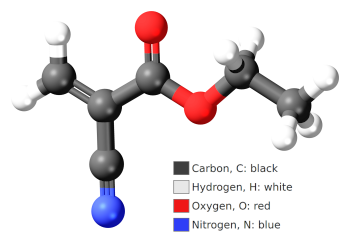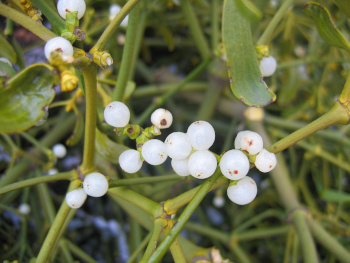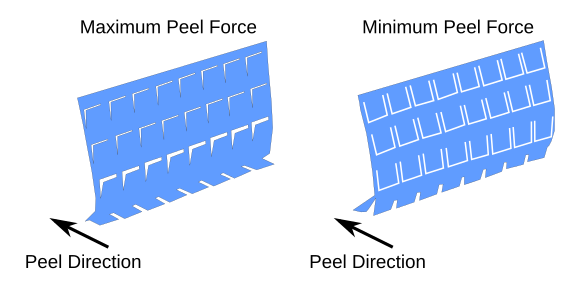Adhesives
December 4, 2023
Most
experiments involve
disparate components that need to be combined.
Physicists through the early
20th century used
sealing wax as an instant
glue. One of the most important items in my
laboratory is two-part
five-minute epoxy, often in a high
viscosity putty form. I've also employed
UV-curable photopolymers that are now much easier to use after the
invention of
UV-emitting LEDs. I sometimes use a
cyanoacrylate adhesive, also known as
superglue.

Ball and stick model of ethyl cyanoacrylate C6H7NO2, a common precursor to cyanoacrylate adhesive, also known as superglue.
(Modified Wikimedia Commons image by Jynto. Click for larger image.)
The first cyanoacrylate polymer was
patented in 1949 by the
B.F. Goodrich Company.[1] Its
research team was looking for a
transparent plastic material that could be used in
optics; but, as frequently happens in
science, its adhesive property was an
accidental result. Their
formulation had the undesirable property that it stuck to everything with which it came in contact. In 1951,
Harry Coover Jr. (1917-2011) and Fred Joyner continued research on cyanoacrylate polymers at
Eastman Kodak, and Kodak eventually marketed its famous
Eastman 910 adhesive in 1958.
Superglue is not entirely
super, since glued components can be separated in
mechanical shear. Superglue also has caused problems when used with
optical components, since excess cyanoacrylate
monomer will
vaporize,
polymerize upon contact with
moisture in the air, and
deposit on
lenses and
filters to reduce transparency and increase
light scattering. I dimly
remember some reports that stress induced by the adhesive has caused
surface cracks on optical components.
As anyone who's wrestled with the
installation a
natural fir Christmas tree knows,
pine sap is extremely
sticky.
Canada balsam cement, the
oleoresin extracted from the
balsam fir (abies balsamea), was used in the past to glue optical components together. It's transparent when
dry, and has a
refractive index of 1.55 that matches that of
crown glass. Today's
synthetic epoxies have replaced Canada balsam cement.

European mistletoe (Viscum album) berries found at Wrocław, Poland.
(Wikimedia Commons image by Agnieszka Kwiecień. Click for larger image.)
As I wrote in an
earlier article (Mistletoe Glue, August 15, 2022),
mistletoe berries have a
coating of
viscin, a natural adhesive consisting of
hierarchically organized
cellulose microfibrils and
mucopolysaccharides.
European mistletoe (Viscum album) is a
parasitic plant species. It was used for
medicinal purposes at the time of the
ancient Greeks, and possibly earlier.[2] Mistletoe's
fiber-reinforced adhesive has an
evolutionary advantage for
seed dispersal of this parasitic plant, since it allows the mistletoe seeds to stick to and
infest host plants.[2]
Adhesives are not the only thing that can bond objects together.
Gauge blocks are
ceramic or
metal blocks that have been
polished to extreme
flatness and
smoothness, and this polishing allows the blocks to be joined together with
interatomic forces in contact. These blocks are known by
machinists as
Jo Blocks in honor of their
originator,
Swedish inventor,
Carl Edvard Johansson (1864-1943), who proved this idea in his
home laboratory.
After further
development, Johansson was granted a Swedish
patent entitled, "Gauge Block Sets for
Precision Measurement," in 1901. He started his own
company in 1917, moved the company to the
United States, and sold the company to
Ford in 1923 to form its Johansson division. He was
posthumously awarded a
gold medal by the
Royal Swedish Academy of Engineering Sciences in 1943.
The mechanism for bonding with adhesives is similar in principle to the interatomic bonding between surfaces in gauge blocks. The adhesive wets the opposing
rough surfaces and
flows onto and into the surface
texture.[3] This allows interatomic bonding between the adhesive material and the rough surfaces. There's quite a bit of
materials science involved in balancing the opposing requirements of adequate flow and
mechanical strength.
Often, adhesive tape is used as a way to temporarily affix something with the idea that it will be removed after it's served its purpose. One painful reminder of this are adhesive
bandages (
band-aids), whose adhesive strength must be strong enough to bond to
skin for a day, or two; but, this leads to difficult removal. A recent
paper in
Nature Materials by
mechanical engineers and
scientists from
Virginia Tech (Blacksburg, Virginia), the
University of Colorado (Boulder, Colorado),
Iowa State University (Ames, Iowa), and the
University of Nebraska - Lincoln (Lincoln, Nebraska) describe a technique that combines strong tape adhesion with easy removal.[4-5] The method uses
U-shaped
cuts in the tape that allow easy removal when pulled in one direction.[4-5]

Illustration of peeling in each direction. It's easy to understand how the flap structure changes the peel strength. On the right, the peeling action is as if the flaps are not present, the adhesive tape acts as a continuous sheet, and removal is mostly by shear force. On the left, the flaps must be pulled from the surface in a direction opposite to the peeling direction. It's as if you're trying to pull the adhesive tape using a force normal to the sheet. (Created using Inkscape. Click for larger image.)
This adhesive tape is a
metamaterial; that is, a material whose properties have been modified by
geometrical structuring. The
U-shaped cuts allow an easy
delamination of the tape when peeled in one direction, and they suppress delamination when peeled in the other direction.[4-5] The
researchers were easily able to create these metamaterial adhesive tapes with
U-shaped flaps of a
millimeter to a few
centimeters dimension using a
laser cutter.[5] The metamaterial tape was able to secure a
picture frame to a
wall 500 times longer (when the
experiment was terminated) than the non-structured tape.[5]
The upper strength of the adhesive can be controlled by changes in the dimension of the
U-shaped flaps and their
areal density.[5] Aside from its
mundane use in adhesive bandages, this approach can be used for
box-sealing tape, lightly adhesive
gloves for fetching and releasing objects, and
robotic grippers.[5]
References:
- Alan E Ardis, "Preparation of monomeric alkyl alpha-cyano-acrylates," US Patent No. 2,467,927, April 19, 1949.
- Nils Horbelt, Peter Fratzl, and Matthew J Harrington, "Mistletoe viscin: a hygro- and mechano-responsive cellulose-based adhesive for diverse material applications," PNAS Nexus, vol. 1, no. 1 (March 16, 2022), Article no. pgac026, pp. 1-11, https://doi.org/10.1093/pnasnexus/pgac026. This is an open access publication with a PDF file available at the article link.
- The Sciences - Ask The Experts, What exactly is the physical or chemical process that makes adhesive tape sticky?, Scientific American, July 14, 1997.
- Dohgyu Hwang, Chanhong Lee, Xingwei Yang, Jose M. Pérez-González, Jason Finnegan, Bernard Lee, Eric J. Markvicka, Rong Long, and Michael D. Bartlett, "Metamaterial adhesives for programmable adhesion through reverse crack propagation," Nature Materials, vol. 22 (June 22, 2023), pp. 1030-1038, https://doi.org/10.1038/s41563-023-01577-2.
- Sarah Wells, "Art-Inspired Tape Is Both Strong and Weak," Physics, vol. 16, no. 125 (July 18, 2023).
Linked Keywords: Experiment; disparate; system; component; physicist; 20th century; sealing wax; adhesive; glue; laboratory; epoxy; five-minute epoxy; viscosity; putty; UV curing; UV-curable; photopolymer; invention; light-emitting diode; UV-emitting LED; cyanoacrylate; ball and stick model of ethyl cyanoacrylate; precursor (chemistry); Jynto; patent; Goodrich Corporation; B.F. Goodrich Company; research; transparent; plastic; material; optics; science; serendipity; accidental result; formulation; Harry Coover Jr. (1917-2011); Eastman Kodak; methyl cyanoacrylate; Eastman 910; shear stress; mechanical shear; optical component; monomer; vaporization; vaporize; polymerization; polymerize; humidity; moisture in the air; physical vapor deposition; deposit; lens (optics); filter (optics); light scattering; memory; remember; surface; fracture; crack; installation art; installation; nature; natural; fir; Christmas tree; pine; sap; sticky; Canada balsam cement; oleoresin; extraction (chemistry); extracted; balsam fir (abies balsamea); solid; dry; refractive index; crown glass (optics); chemical synthesis; synthetic; European mistletoe (Viscum album); berry; Wrocław, Poland; Wikimedia Commons; Agnieszka Kwiecień; coating; viscin; hierarchy; hierarchical; cellulose microfibrils; glycosaminoglycan; mucopolysaccharide; parasitic plant; species; medicine; medicinal; Ancient Greece; ancient Greeks; fiber-reinforced; fitness (biology); evolutionary advantage; seed dispersal; infestation; infest; host (biology); gauge block; ceramic; metal; cuboid; block; polishing; polished; flatness (manufacturing); smoothness; intermolecular force; interatomic force; machinist; inventor (patent); originator; Sweden; Swedish; Carl Edvard Johansson (1864-1943); home; research and development; precision; measurement; company; United States; Ford Motor Company; posthumous award; gold; medal; Royal Swedish Academy of Engineering Sciences; surface roughness; fluid dynamics; flow; surface finish; texture; materials science; strength of materials; mechanical strength; bandage; band-aid; skin; scientific literature; paper; Nature Materials; mechanical engineering; mechanical engineer; scientists; Virginia Tech (Blacksburg, Virginia); University of Colorado (Boulder, Colorado); Iowa State University (Ames, Iowa); University of Nebraska - Lincoln (Lincoln, Nebraska); cut; peeling; flap structure; plane (geometry); sheet; shear stress; shear force; force; orthogonality; normal; inkscape; metamaterial; geometry; geometrical; surface micromachining; structuring; delamination; research; researcher; millimeter; centimeter; dimension; laser cutting; laser cutter; picture frame; wall; experiment; area density; areal density; mundane; box-sealing tape; glove; robot end effector; robotic gripper.